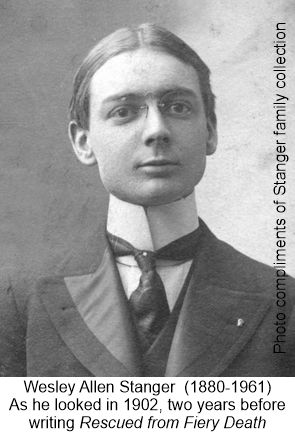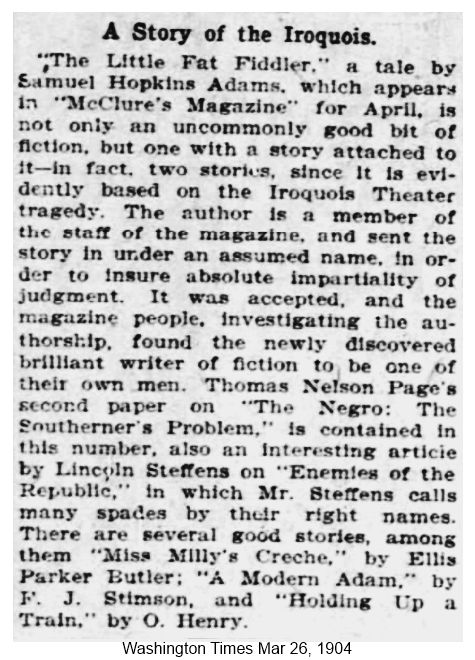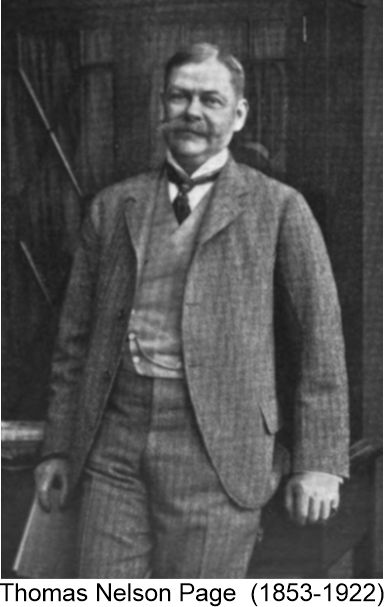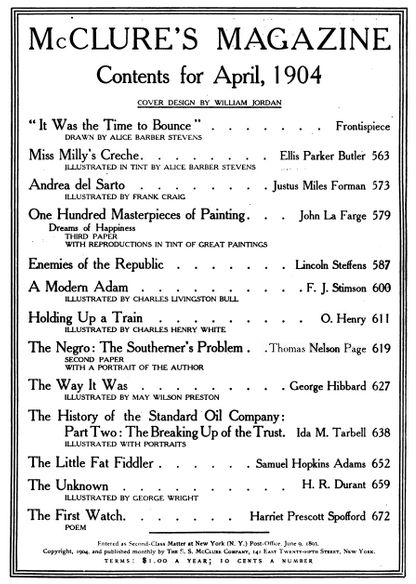|
Rescued from Fiery Death
by
Wesley Allen Stanger (1880–1961)
Wes Stanger worked as a newspaper reporter and editor in
Cincinnati, Buffalo, NY and Chicago before turning
to office equipment sales and publishing. His novel
about the Iroquois fire, Rescued from Fiery Death
is a little odd but offers one of the few period pictures of the lamp that started the
Iroquois Theatre fire. It originally appeared in the
newspaper where the image quality was very poor.
Stanger also wrote a how-to series on selling, using
Thomas Edison's marketing of the Ediphone as the feature example, and briefly
published a magazine named Illumination. These
associations suggest his interest in lighting may
have been more than casual, perhaps motivating him
to make an extra effort to see and acquire a photo
of the Iroquois lamp.

Stanger's book contains several illustrations from
newspaper stories about the fire, and from
Marshall Everett's disaster book.
From Chicago: its history and its builders, a century of marvelous growth by Josiah Seymour Curry, 1912:
"Wesley A. Stanger, the editor of The
Office Outfitter, is a native of Chicago and resides
at 1525 Davis street, Evanston. He has completed
three decades of his life's journey. He comes of
English-American parentage and has remained
continuously in this city save for brief periods. On
one occasion his father removed with his family to
Kansas but arrived there just as the boom of 1888-90
was being terminated so that he soon afterward
returned. Having completed Ills education in the
Evanston schools Mr. Stanger entered the field of
newspaper publication, his initial experience being
gained with the Evanston Press and the Chicago
Times-Herald. Later he was a member of the
Chicago Tribune staff and was tile first reporter
employed by William Randolph Hearst when he entered
the journalistic field in Chicago. Mr. Stanger's
connection with the Tribune was that of
assignment reporter and afterward police reporter,
which latter position he accepted on leaving the
service of Mr. Hearst. For a time he was connected
with the Commercial Tribune of Cincinnati
as a writer of
Sunday feature stories and subsequently went to
Buffalo, New York, where he became telegraph and
later city editor of the Buffalo Review, a paper
that has since passed out of existence. He was also
known in journalistic circles of Chicago as a member
of the Inter Ocean staff' but withdrew from the
newspaper business to enter the employ of Rockwell &
Rupel as special representative, in which connection
he established agencies in many cities for this
firm, engaging in manufacturing filing systems,
card-index systems, office fixtures, etc. He was
manager for the house in St. Louis, Buffalo and
other cities, taking charge of territories and
developing the business to a point where it was
productive and profitable, after which he
established resident managers.
"Mr. Stanger was married in Evanston, on
the 24th of May, 1905, to Miss Jennie M. Price,
and they have a son, Wesley Allen, Jr., born in
April, 1909. At the time of his marriage Mr. Stanger
reentered the publishing business as editor and
manager of the General Merchants Review
in Chicago, which was later purchased by the Root
Newspaper Association. He was especially successful
with that proposition and when consolidation was
effected became editor and publishing director of
Office Appliances, the most
successful paper in this field and one of the
largest in its class in the country. It was a factor
of little force when Mr. Stanger assumed control but
through unfaltering application and the capable
direction of its interests, combined with a thorough
understanding of such work, he made it the leader in
the business. At length he withdrew to join Edward
C. Thurnau in establishing The Office Outfitter and
later he purchased his partner's interest. He also
began the publication of a trade magazine called
Illumination which he sold. The Outfitter today is
one of the best trade papers published and is still
successful conducted by Mr. Stanger.
"Mr. Stanger was the promoter of the first successful and
permanent school organization in Evanston, with
Ellen E. Foster as principal, by organizing the
neighborhood of the Foster street school which led
up to the establishment of neighborhood clubs
organized around the schools. The Neighborhood Club
of the Poster street school is still flourishing. It
was formed for the purpose of providing means of
cooperation between teachers and parents and to
supply amusements for children, and has resulted in
the entire organization of the school along lines of
self government. One of its features is the
providing of illustrated lectures and entertainments
for monthly meetings. Mr. Stanger has taken an
active part in practically every civic movement in
Evanston for many years and is a worker in local and
state politics. He has never believed in accepting
the benefits of citizenship and of government
without adequate return in service for the upholding
of the political status. He was a delegate to
the last state convention at Spring- field before
the passage of the direct primary law. He is
unfaltering in his advocacy of republican principles
and has been twice candidate for state
representative, losing the first time by about five
hundred votes and the second by three hundred and
sixty-four votes, in a factional fight in the party
over the Lorimer scandal, his position being against
the Lorimer faction. None there are who know aught
of the history of Evanston but recognize and
acknowledge the worth of his service in matters
relative to the public welfare. He is a member of
the supervising committee of Mason Park and belongs
to the Small Parks and Playground Association of
Evanston. He has ever manifested a deep and helpful
interest in the vital and significant questions of
the day, whether of local or national importance. He
belongs also to the Chicago Press Club; to Evanston
Lodge, No. 524 F. & A. M.; Evanston Chapter, No.
144, R. A. M.; and to Evanston Historical Society
and the Young Men's Civic Club of Evanston. He
affiliates with the Church of Christ Scientist and
in all of his work in behalf of humanity, whether
done in the name of religion or otherwise, his
efforts have proven a potent force in the attainment
of practical results."
He was also advertising manager at Moving Picture
Review & Theatre Management in the early 1930s.
|
 |
The Fat Fiddler short story,
McClure's Magazine April, 1904
by Samuel Hopkins Adams (pen
name of Thomas Nelson Page 1852–1922)
Page didn't have a reputation for fiction and
reportedly submitted the story under a pen name to
see if it would be accepted by McClure's editors.

Though Fat Fiddler did not mention the
Iroquois Theater, Page made little effort to conceal
the connection. Comedian
Eddie Foy is represented by Benny Hughes performing as Hob the Goblin Prince,
like Foy, wearing an outlandish costume. Dolph, hero of
the story, is first violin/music director
Antonio Frosolono. Aerial dancer
Nellie Reed is Maida Corwin
of the Tarzanian balcony escape. Dillon is orchestra
director
Herbert Dillea. Inclusion of an aerial wire in
causing the fire was in keeping with inaccurate speculation
immediately after the fire, soon corrected in witness testimony
published after Page completed his story.
In 1887–1914 the author,
Thomas Nelson Page, was a
leading purveyor of Lost Cause sentiments,
condemning post-war blacks and glorifying the Old
South. "Page, helped popularize the images of
cheerful and devoted Mammies and Sambos in his early
books, became one of the first writers to introduce
a literary black brute."


Page's romance story appeared along with one by a
more popular story teller, O Henry, who began to hit
his stride in 1904. Also in the issue was Part
2 of
Ida Tarbell's historic articles about Standard
Oil.
Another entry by Thomas Page appeared in the issue, under his real
name. It was Part 2 of an offensive series about negroes
and the south.
|
